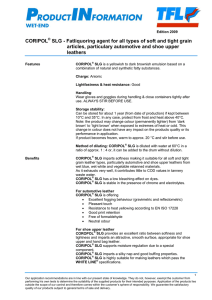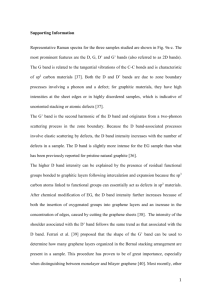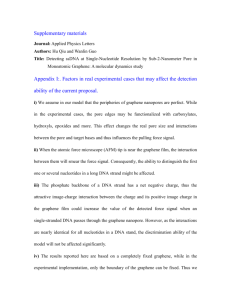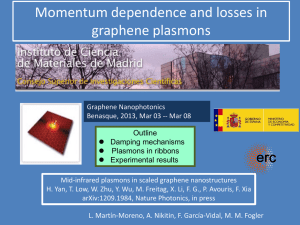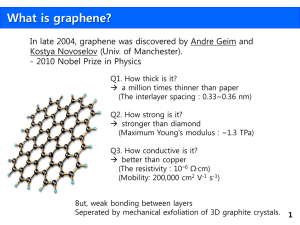Supplementary Information (doc 5688K)
advertisement
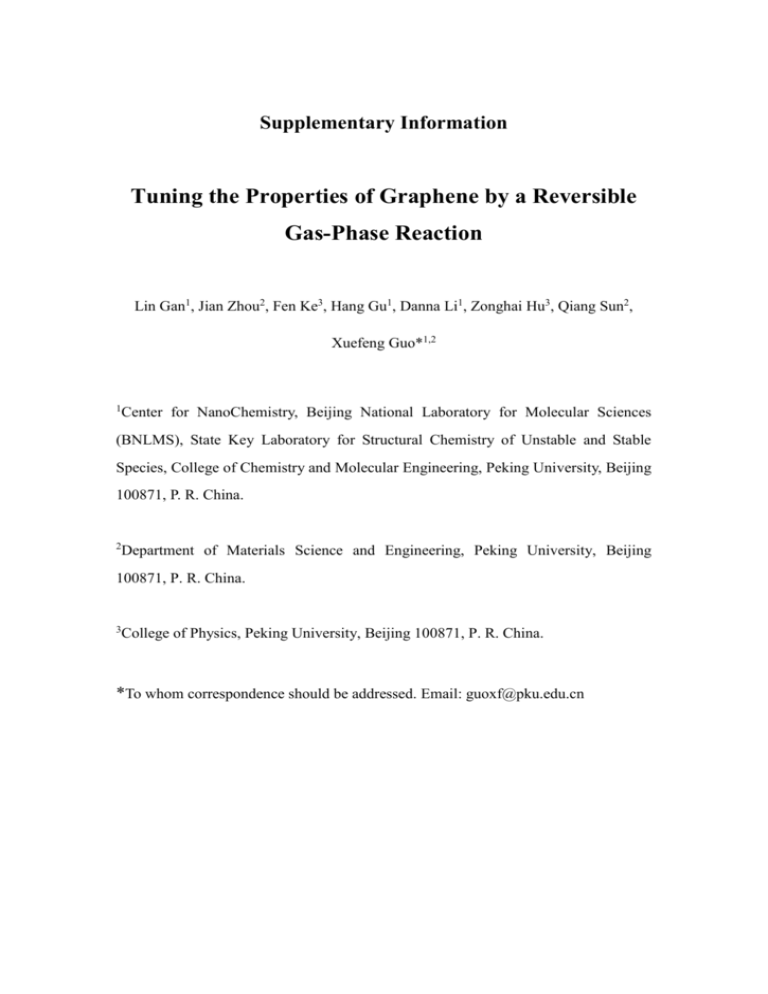
Supplementary Information Tuning the Properties of Graphene by a Reversible Gas-Phase Reaction Lin Gan1, Jian Zhou2, Fen Ke3, Hang Gu1, Danna Li1, Zonghai Hu3, Qiang Sun2, Xuefeng Guo*1,2 1 Center for NanoChemistry, Beijing National Laboratory for Molecular Sciences (BNLMS), State Key Laboratory for Structural Chemistry of Unstable and Stable Species, College of Chemistry and Molecular Engineering, Peking University, Beijing 100871, P. R. China. 2 Department of Materials Science and Engineering, Peking University, Beijing 100871, P. R. China. 3 College of Physics, Peking University, Beijing 100871, P. R. China. *To whom correspondence should be addressed. Email: guoxf@pku.edu.cn Fig. S1: Schematic representation of the fabrication procedure to form graphenebased transistor arrays. b a c SLG 250 mm d 70 mm e Intensity (a.u.) 2D G SLG 1200 1600 2000 2400 2800 Raman Shift (cm-1) 3200 4 nm Fig. S2: a, An optical image of large-area graphenes after PMMA-mediated nanotransfer process on a silicon wafer. b, Schematic representation of the SLG device array. c, The enlarged optical image of a representative device. The average width of graphene sheets is 70 mm. d, A representative Raman spectrum of the grown graphene. e, A representative high-resolution TEM image of SLG. Intensity (a.u.) Fig. S3. Intensity profile plot along the line indicated by the arrows in Fig. 3e. The intensities of the diffraction spots from outer hexagon is equivalent to that from inner hexagon, confirms that our graphene samples are single-layer1. Intensity (a.u.) Before plasma methylation After plasma methylation O 1s C 1s N 1s 350 400 450 N 1s O 2s 0 10 20 30 40 50 200 300 400 Binding Energy (eV) 500 600 Fig. S4. XPS spectra of a SLG sample before and after plasma methylation. Inset shows the enlarged N 1s XPS spectra. We find that the amount of O and N atoms were strongly suppressed after plasma treatment. a 1.2 8 nm Height = 0.49 nm Height (nm) 0.8 0.4 0.0 -0.4 -0.8 0 nm -1.2 0.0 1 mm b 0.5 1.0 1.5 2.0 1.5 2.0 Distance (mm) 1.2 8 nm Height = 0.70 nm 0.8 Height (nm) 0.4 0.0 -0.4 -0.8 -1.2 -1.6 0 nm 1 mm -2.0 0.0 0.5 1.0 Distance (mm) Fig. S5. AFM images of the same SLG sample before (a) and after plasma methylation (b). The average changes in graphene thickness after plasma methylation is 0.21nm. Theoretical computations. Our calculations were based on density functional theory (DFT) with generalized gradient approximation (GGA) for the exchange-correlation energy. We have used the Perdew-Burke-Ernzerhof (PBE)2 for the GGA and a plane-wave basis set with the projector-augmented-wave (PAW) method originally developed by Blochl3 and adapted by Kresse and Joubert in the Vienna ab initio simulation package (VASP)4. We used periodic boundary condition to simulate the two-dimensional methylated SLG along x and y direction, and along z direction we set vacuum space of 15 Å to avoid the interactions between two neighboring images. We also applied Monkhorst-Pack meshes5 of (7 7 1) to represent the reciprocal spaces. All the structures were relaxed through conjugated gradient method without any symmetric constraints. The energy cutoff and convergence criteria for energy and force were set to be 400 eV, 1 10-4 eV, and 0.01 eV/Å, respectively. The accuracy of the above procedure has been well tested in our previous work6. Band structures of graphene after plasma treatment. In order to better understand the methylated SLG sheets, we performed first-principles density-functional calculations to investigate their band structure, orbital distribution, and elastic modulus using Vienna Ab initio Simulation package (VASP)3. Based on the experimental finding, the geometry of methylated SLG sheets is shown in Fig. S6(a). After geometric relaxation, the unit cell lattice constant is found to be 4.98 Å and the C-C bond lengths with sp3 and sp2 hybridizations in the graphene are 1.51 and 1.53 Å, respectively. Such a configuration is found to be energetically most stable with at least 0.913 eV lower in energy than other configurations (Supplementary Fig. S7). Due to the surface absorption, graphene could not retain its planar structure and the sp3 C atoms move outward. The formation energy, defined as Ef (=Emethylated SLG – ESLG – ECH4), is found to be 1.97 eV/unit cell. The positive value indicates that the reaction of surface decoration is endothermic, and thus the demethylation and dehydrogenation process can be achieved easily. It should be noted that the reaction of full hydrogenation on SLG (forming graphane) is exothermic, suggesting that it is more difficult to remove its surface hydrogen atoms. To gain some details of bonding features, let’s check the electron redistribution upon the surface decoration, as shown in Fig. S6(b) for the charge difference density △ρ (=ρmethylated SLG – ρCH3 – ρH – ρSLG). We can see that electrons are slightly accumulated around the functional groups (methyl and hydrogen). a y x b Fig. S6. a, Geometric model of the methylated SLG and its corresponding bond lengths. The dashed rhombus is the unit cell. b, Isosurface of charge difference density of the methylated SLG, green for positive and blue for negative values. Fig. S7. Relative energies and magnetic moments per unit cell of different configurations of the methylated and hydrogenated SLG. As shown in this figure, we examine the relative energies and magnetic moments per unit cell of the three configurations with fixed methyl and hydrogen concentration. It shows that the most energetically favorable conformer is that hydrogen absorbs at the para-position of the methyl, while the conformer of hydrogen at meta-position of the methyl has the highest energy. This is because the ortho-position absorption will induce larger distortion and the meta-position absorbed conformer is magnetic7. We then examined the electronic properties of this methylated SLG. The calculated band structure and partial density of states (PDOS) are shown in Fig. S8. The system is found to be nonmagnetic with an indirect band gap of 3.63 eV around the Fermi level, which is comparable with that of graphane (3.50 eV with a direct band gap)8. The PDOS shows that the gap is mainly dominated by the 2p orbitals of the C atoms. In order to examine it in detail, we plotted wave functions of the highest valence band (HVB) and the lowest conductance band (LCB). We can see that both of them are contributed by the C atoms of SLG; the HVB has delocalized π character while the LCB has localized π* character. We then anticipate that the band gap of SLG can be modulated in a large range under different coverages. 5 0 0 -5 K M Energy (eV) EF 5 p s -5 -10 -10 0 5 10 15 PDOS (e/eV) Fig. S8. Band structure (right), PDOS (middle) and wave functions of frontier bands (left) for the methylated SLG. Finally, we considered the mechanical property of the methylated SLG. A rectangle unit cell is used to calculate the elastic constant C along x and y directions. The elastic constant can be written as C 2E / S0 l2 / l2 where E and l are deformation energy and lattice constant along α (= x and y) directions, respectively. The total energy variation with respect to unit cell deformation is plotted in Fig. S9, where we can deduce the values of Cx (326.6 N/m) and Cy (419.9 N/m), respectively. These values are comparable to the average experimental elastic modulus of 342 N/m in pristine graphene sheet9 but they are larger than those of graphdiyne (158.57 and 144.90 N/m)10. 10 along x 8 E (meV) along y 6 4 2 0 -0.004 -0.002 0.000 l /l0 0.002 0.004 Fig. S9. Total energy variation per unit cell with respect lattice deformation along x and y directions. The curves are the parabola fitting. 1. 2. 3. 4. 5. 6. 7. 8. 9. 10. Ferrari, A.C. et al. Raman spectrum of graphene and graphene layers. Phys. Rev. Lett. 97, 187401 (2006). Perdew, J. P., Burke, K. & Ernzerhof, M. Generalized gradient approximation made simple. Phys. Rev. Lett. 77, 3865 (1996). Kresse, G. & Furthmuller, J. Efficient iterative schemes for ab initio total-energy calculations using a plane-wave basis set. Phys. Rev. B 54, 11169-11186 (1996). Kresse, G. & Joubert, J. From ultrasoft pseudopotentials to the projector augmented-wave method. Phys. Rev. B 59, 1758-1775 (1999). Monkhorst, H. J. & Pack, J. D. Special points for Brillouin-zone integrations. Phys. Rev. B 13, 5188-5192 (1976). Zhou, J., Wang, Q., Sun, Q., Chne, X. S., Kawazoe, Y. & Jena, P. Ferromagnetism in semihydrogenated graphene sheet. Nano Lett. 9, 3867-3870 (2009). Zhou, J., Wang, Q., Sun, Q., Chne, X. S., Kawazoe, Y. & Jena, P. Ferromagnetism in semihydrogenated graphene sheet. Nano Lett. 9, 3867-3870 (2009). Sofo, J. O., Chaudhari, A. S. & Barber, G. D. Graphane: A two-dimensional hydrocarbon. Phys. Rev. B 75, 153401 (2007). Lee, C., Wei, X., Kysar, J. W. & Hone, J. Measurement of the elastic properties and intrinsic strength of monolayer graphene. Science 321, 385-388 (2008). Long, M., Tang, L., Wang, D., Li, Y. L. & Shuai, Z. G. Electronic structure and carrier mobility in graphdiyne sheet and nanoribbons: Theoretical predictions. ACS Nano 5, 2593-2600 (2011).
